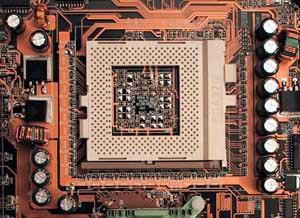ABIT BX133-RAID i440BX Socket-370 ATX
by Mike Andrawes on July 28, 2000 12:00 PM EST- Posted in
- Motherboards
In the quest for the ultimate i440BX board, ABIT's also outfitted the BX133-RAID with a 5/1/1/0 (PCI/ISA/AGP/AMR) expansion slot configuration. There are no AMR or CNR slots, nor will there be ever since the i440BX chipset does not support them. The solder pads for a 6th PCI are clearly visible on the board, but just like the BE6-2, this connector is left out because we'd have entirely too many PCI devices without a PCI bridge. As it stands, Intel's PIIX4e South Bridge only supports 5 PCI master devices, and one of those is used up by the onboard HighPoint controller. That means that the 5th PCI slot is actually a slave slot, meaning that no bus mastering devices will function in that slot, but something like a Voodoo2 will work fine. Unfortunately, few current PCI devices can operate in slave mode.
While Tyan and a few others have used a PCI-PCI bridge chip to work around this issue on their 6 PCI motherboards, we think that MSI has a much more elegant and cost effective solution - a PCI arbiter chip. Read our review of the MSI BXMaster for more information on their PCI arbiter chip. The AGP slot shares an IRQ with either the first or the second PCI slot, the fourth and fifth slots still share an IRQ with the USB controller, and the third slot shares an IRQ with the onboard HPT370 controller.
Support for up to 768MB of RAM is provided by 3 DIMM slots. Unfortunately, we did encounter a bit of a problem when running more than 1 DIMM at 133 MHz - regardless of the memory type in use, the system was not stable with more than 1 DIMM at a CAS latency of 2. Turning down the timing to CAS 3 brought stability back to normal, but at a small performance penalty.
As the name suggests, the BX133-RAID is designed with 133 MHz operation in mind and is semiofficially supported this time around. Obviously Intel doesn't condone operation of the i440BX at 133 MHz and ABIT still has the disclaimer in the manual that bus speeds other than 66 or 100 MHz are not guaranteed. Nevertheless, ABIT's success comes from catering to overclockers and that's what they've done here again with the BX133-RAID. That means we get SoftMenu III again, providing for a total of 120 FSB speed settings, more specifically standard 66 / 75 / 83 settings plus speeds from 84 - 200 in 1MHz increments. There is still support for adjusting the PCI ratio (1/2, 1/3, or 1/4 of the FSB speed), AGP ratio (2/3 or 1/1 of the FSB speed), and CPU core voltage (default +/- 0.3V). SoftMenu III also offers the ability to adjust the I/O voltage of the PCI / AGP bus and SDRAM to 3.2 - 3.9V in 0.1 V steps (default is 3.3V), as well as some options for L2 cache latency, all in an effort maximize overclocking potential. The defaults for all these settings are clearly labeled, so causing serious damage will take a bit of work.
 Like
the BF6 and BE6-2, the BX133-RAID features a set of 10 dip switches that can
override the otherwise jumperless SoftMenu III features onboard This is mainly
for OEMs and system integrators concerned with their customers playing around
in the BIOS and potentially causing support headache. As such, it really doesn't
apply to most hardware enthusiasts.
Like
the BF6 and BE6-2, the BX133-RAID features a set of 10 dip switches that can
override the otherwise jumperless SoftMenu III features onboard This is mainly
for OEMs and system integrators concerned with their customers playing around
in the BIOS and potentially causing support headache. As such, it really doesn't
apply to most hardware enthusiasts.
To help ensure that things stay nice and stable during all this overclocking, ABIT has included eleven 1500uF and ten 1000uF capacitors around the Socket-370 interface to provide sufficient power to the CPU under all conditions. ABIT's left plenty of room around the CPU socket such that FC-PGA-C heatsinks can be mounted to the CPU. An FC-PGA-C heatsink is just an oversized heatsink designed for CPU's running at 1 GHz and above. We also see the return of ABIT's oversized green heatsink, last seen on the BP6 and the original BE6, atop the i443BX North Bridge. This careful selection of components, combined with the tried and true layout from previous ABIT BX boards allowed the BX133-RAID to run rock solid during our stress tests. With the KA7 and now the BX133-RAID, we're definitely seeing a positive move by ABIT to focus more on stability, a trend we certainly encourage.
Hardware monitoring is provided by the good old Winbond 83782D hardware monitoring chip. That means 9 voltages, 3 temperatures, and 3 fan speeds are monitored. As we've come to expect from ABIT, a thermistor was included in the box to support the monitoring of any device in the system. This thermistor simply attaches to a header on the motherboard. CPU temperature is read via the on die thermal diode of all Socket-370 CPU's. Two fan headers are right next to the CPU, while the third is at the front of the board in front of the expansion slots.
ABIT's highly regarded user's manual is once again found in the BX133-RAID's box, giving users a step-by-step installation and a configuration guide for their system. The ABIT manual includes a fairly easy to read and useful explanation of the BIOS, CPU setup, RAID configuration, and makes the overall experience with the BX133-RAID, especially for first time system builders, a pleasant one.











0 Comments
View All Comments